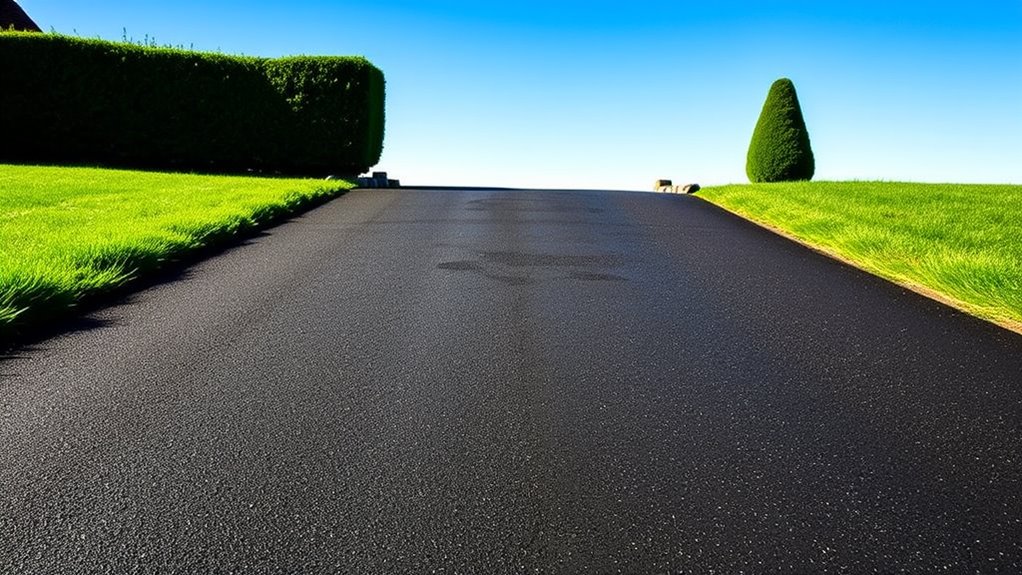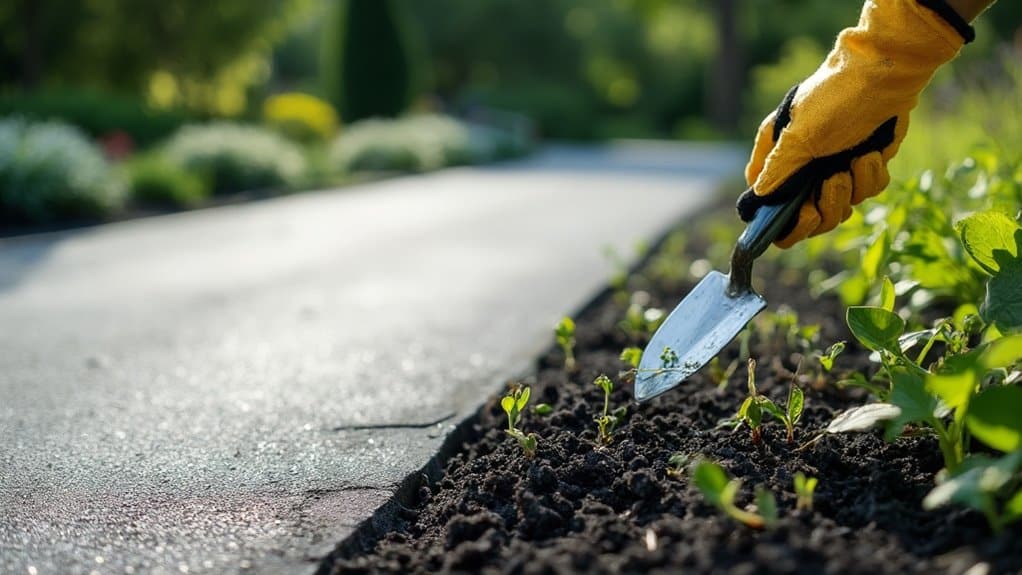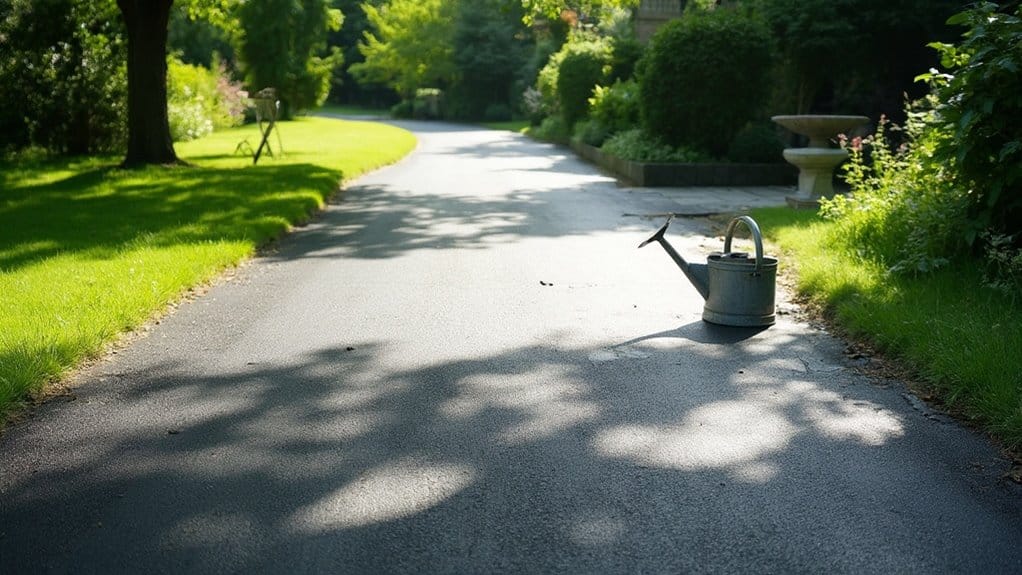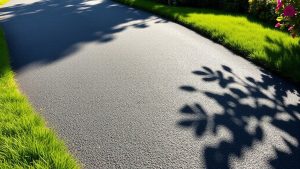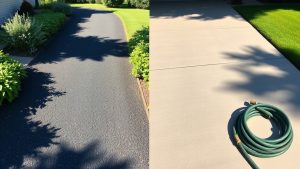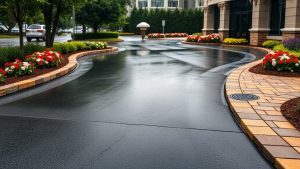To remove weeds from cracks in your concrete driveway, start by hand-pulling the weeds when the soil is moist. You can also use a vinegar solution or salt to kill the weeds naturally, but be careful not to harm any nearby plants. For more stubborn weeds, consider using a non-selective chemical herbicide, ensuring you follow all safety guidelines. Regular maintenance, such as sealing cracks and using polymeric sand, can help prevent future weed growth. Keep your driveway looking tidy and weed-free with these simple strategies.
Table of Contents
ToggleKey Takeaways
- Hand pull weeds from cracks when the soil is damp to ensure complete root removal and prevent regrowth.
- Use a vinegar solution or salt directly on the weeds for natural herbicidal effects, but be careful around nearby plants.
- Apply a non-selective herbicide such as glyphosate for effective weed control, ensuring you follow safety guidelines and wear protective gear.
- Fill cracks with flexible concrete sealant to stop future weed growth and maintain the integrity of your driveway.
- Regularly check and power wash the driveway to clear debris and limit weed growth, especially in spring and summer.
Natural Weed Removal Methods
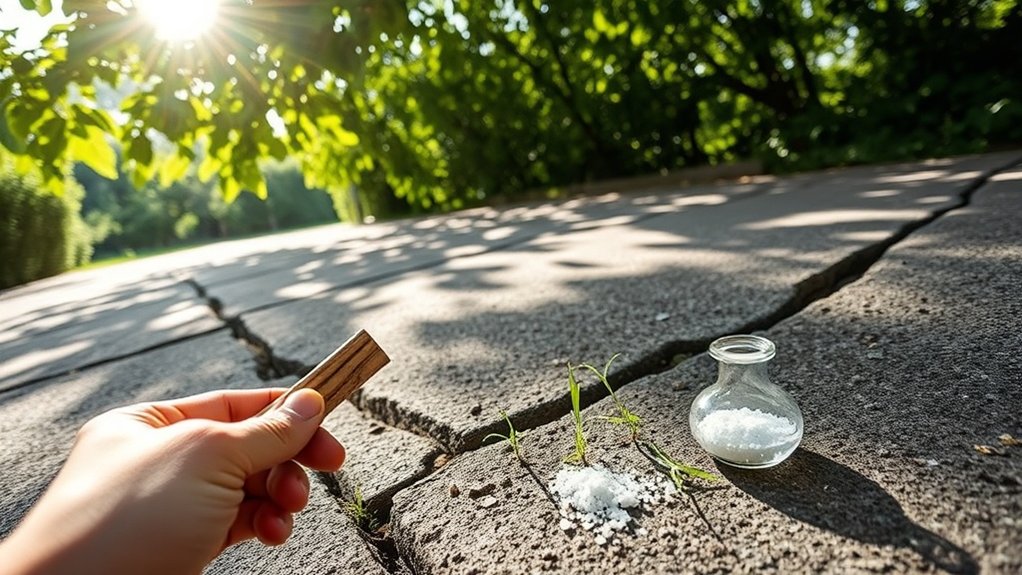
Natural weed removal methods provide effective solutions for managing unwanted growth in cracks of concrete driveways without using harsh chemicals. A vinegar solution works well as a natural herbicide, causing young weeds to wilt and dehydrate. For better results, mix vinegar with a bit of dish soap to help it stick to the leaves. Salt can also be used to dehydrate plants, effectively killing the weeds when applied directly. However, be careful, as salt is non-selective and can damage nearby plants and soil health if used excessively. Regular maintenance is essential to prevent weed growth from returning after treatment. It’s best to apply salt during dry weather to minimise runoff. Combining these methods may require several applications for stubborn weeds, but you’ll adopt a more environmentally friendly approach to weed management in your driveway.
Mechanical and Manual Removal Techniques
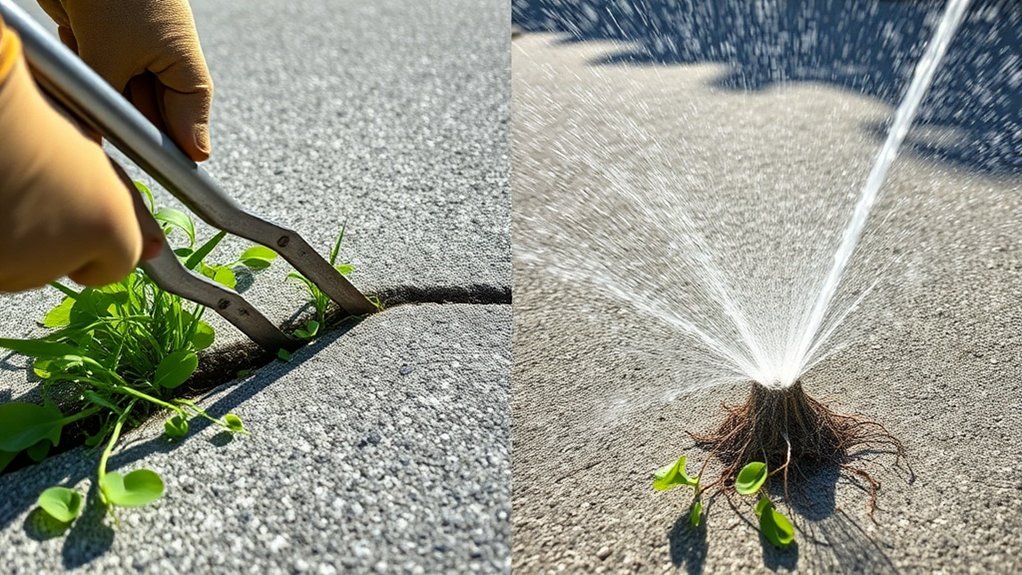
When dealing with weeds in the cracks of a concrete driveway, you can use both manual and mechanical methods to remove them effectively. Hand pulling is a reliable way to remove weeds by the roots, while strimmers are useful for cutting them down at the surface. For a deeper clean, pressure washing can help remove dirt and debris, making it easier to manage weeds in the long run. Additionally, addressing temporary solutions for weed control is essential to prevent them from becoming thicker over time.
Hand Pulling Weeds
Hand pulling weeds from the cracks in your concrete driveway requires a careful approach to ensure effective removal and to reduce the chances of regrowth.
Start by checking that the soil is damp, as this makes it easier to pull out the weeds without breaking their roots. Use tools like a flathead screwdriver or a weeding knife to dig deep into the cracks. Clear away any dirt or debris first to get a better grip on the roots.
When pulling the weeds, hold them firmly and pull straight out to avoid snapping the stem. Take your time to ensure you remove the entire root system. Once removed, dispose of the weeds well away from your driveway to prevent them from growing back. Weeds growing in driveway or sidewalk expansion joints is a common issue that requires regular maintenance to ensure they do not return.
Regular maintenance is important, as some weeds may return if any roots are left behind.
Using String Trimmers
String trimmers are a practical tool for tackling weeds in the cracks of concrete driveways, using both mechanical and manual methods. By opting for twisted line models, you can effectively trim weeds and grass flush with the concrete surface.
Here are some key points to consider:
- Use appropriate trimming techniques for edges and expansion joints.
- Attachments like wire wheels can help remove stubborn debris.
- Different line thicknesses can enhance cutting efficiency in tougher areas.
- Regular trimming prevents weeds from maturing and spreading seeds.
While string trimmers are effective, be aware that they may not remove roots or compacted soil.
Always follow up with a clean-up to minimise regrowth and keep your driveway looking its best.
Pressure Washing Cracks
Effective pressure washing can significantly improve your ability to remove weeds from cracks in your concrete driveway.
Using hot water pressure washing techniques combines heat and high pressure, which helps to dislodge weeds and sterilise the area to prevent regrowth. Aim the high-pressure stream directly into the cracks and consider using a turbo nozzle for a more powerful impact on stubborn weeds.
Adjust the pressure with a ball valve to avoid damaging the surface. While pressure washing is effective for removing many weeds, it’s crucial to manually dig out any remaining roots afterwards. Additionally, it is important to choose the right nozzle to prevent etching and ensure effective cleaning.
This two-step approach ensures a thorough clean, helping to maintain the integrity of your driveway and reduce future weed growth and damage.
Chemical Weed Killers and Herbicides
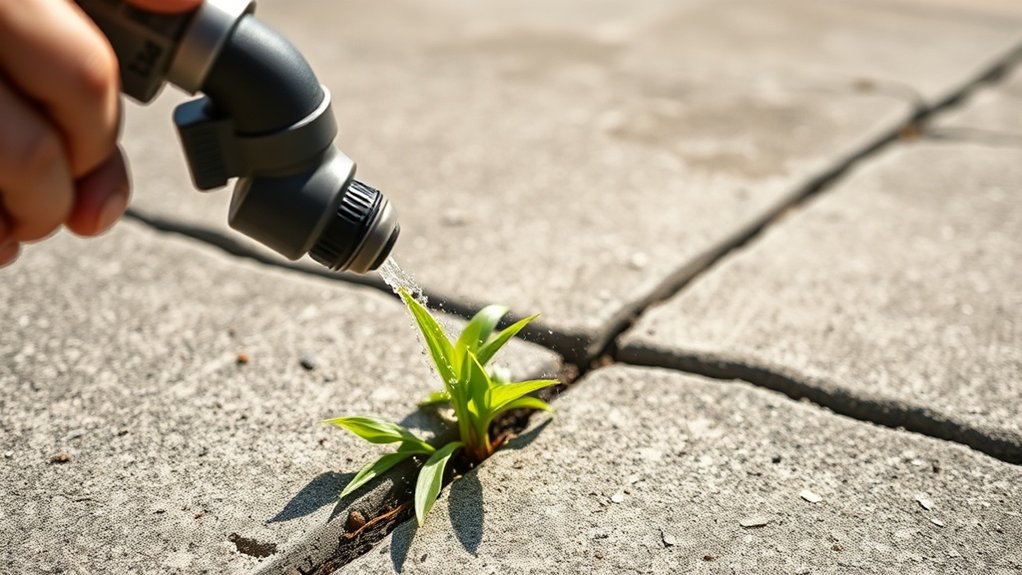
When dealing with weeds in the cracks of a concrete driveway, chemical weed killers and herbicides can be an effective solution. Here are some important points to consider:
- Non-selective herbicides like glyphosate kill all plants, making them suitable for driveways where there are no desired plants.
- Systemic herbicides work by being absorbed into the plant, destroying it from the inside over time.
- Contact herbicides provide quick results on the surface but don’t eliminate the roots.
- Always prioritise chemical safety by following manufacturer guidelines and wearing protective gear.
Be cautious about your environment to avoid harming nearby plants and ensure compliance with local regulations.
If safety is a concern, consider herbicide alternatives for smaller weed problems.
Regularly check and maintain your driveway to prevent the return of weeds and ensure lasting results.
Preventive Measures for Weed Control
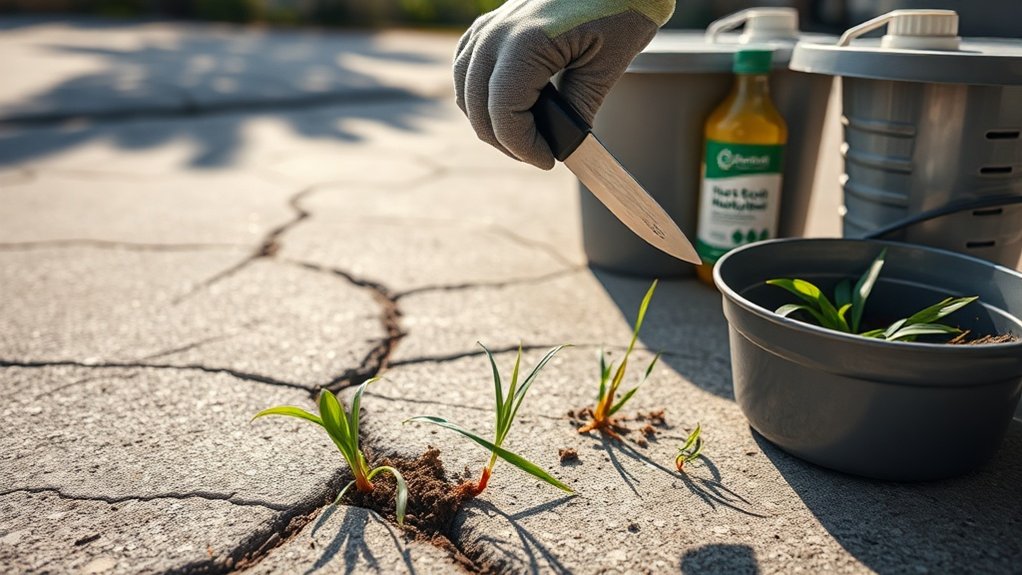
To prevent weeds from taking root in your concrete driveway, it’s important to use a mix of physical barriers and regular maintenance.
Start by laying down weed-proof mesh or heavy-duty landscaping fabric beneath the concrete to block weed roots. Seal any cracks or gaps with flexible concrete sealant, making sure to clean them properly first. Regularly check and reseal these areas to keep the barrier effective.
You might also use polymeric sand between paving stones to deter weeds. Additionally, planting weed-resistant plants nearby can help reduce seed spread. Keeping your driveway clear of organic debris will further stop germination, making your weed control efforts more successful. Regular maintenance, such as jet washing to clean stubborn dirt and stains, can also help prevent weed growth.
Risks and Considerations in Weed Removal
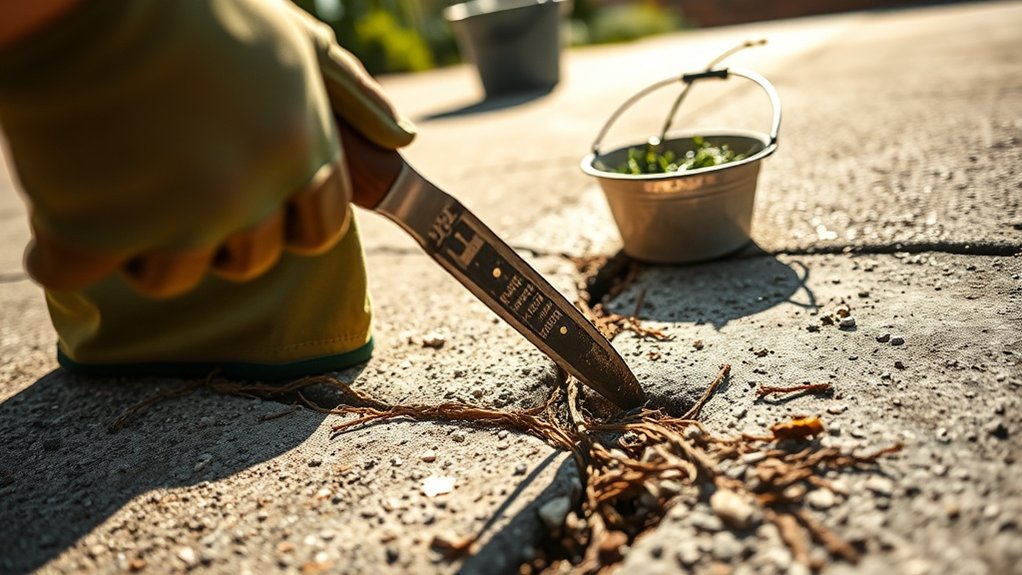
Even with preventive measures, weeds can still appear in your concrete driveway, requiring removal.
When addressing this issue, it’s important to consider the risks and safety precautions involved:
- Fire hazards when using propane torches near flammable materials.
- Chemical exposure risks for people, pets, and wildlife from improper herbicide use.
- Environmental impact from runoff that can contaminate nearby ecosystems.
- Physical damage to the concrete from aggressive removal techniques.
Always wear protective gear when using chemicals or flames, and be aware of the weather to limit environmental harm.
Consider safer options, such as hot water pressure washing, which are better for both you and the environment.
Striking a balance between effectiveness and safety is crucial for successful weed control.
Long-Term Maintenance Strategies
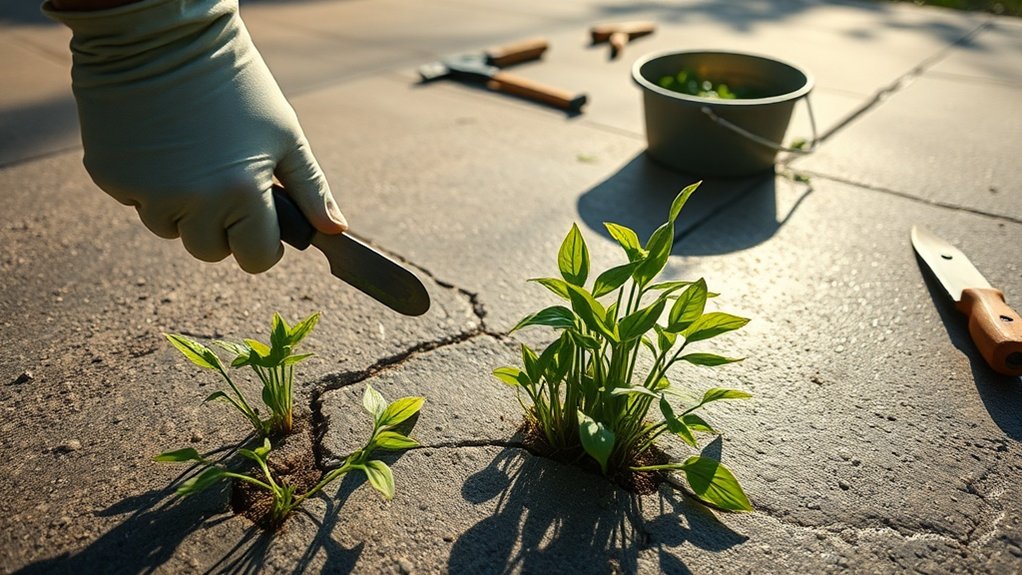
To ensure long-term effectiveness in weed management, combine removal techniques with preventative measures.
Use granular pre-emergent herbicides to stop new growth and schedule regular inspections to catch emerging weeds early.
Combined Removal Techniques
Combining various removal techniques is crucial for the long-term upkeep of weed-free concrete driveways. By using a mix of methods, you can effectively tackle both visible weeds and their roots.
Here are some practical approaches:
- Manually pull weeds when the soil is damp to ensure you remove the entire root.
- Use tools like soil knives to make root removal quicker and easier.
- After pressure washing, seal the surface to stop weeds from regrowing due to soil deposits.
- Carefully apply non-selective herbicides to kill existing weeds without damaging nearby plants.
These strategies will help keep your driveway looking clean and well-maintained.
Granular Pre-Emergent Herbicides
To keep your concrete driveway free from weeds, granular pre-emergent herbicides are a reliable long-term solution. These products form a barrier that stops weed seeds from germinating for up to eight months. For optimal results, apply them before weeds sprout, ensuring even coverage with the right techniques.
| Application Technique | Environmental Impact |
|---|---|
| Use push or hand-held spreaders | Minimal runoff due to low mobility |
| Water within three days post-application | Quick breakdown reduces harm to soil and water |
| Avoid excess on the driveway surface | Prevents staining and buildup on concrete |
Scheduled Inspections and Treatments
To keep your concrete driveway free from weeds, it’s essential to implement a regular inspection and treatment routine alongside preventive measures like granular pre-emergent herbicides. A structured approach allows you to address issues early, reducing the need for extensive treatments.
- Inspect your driveway each season to spot new weed growth.
- Keep a record of any cracks, noting their size and location for future reference.
- Power wash your driveway twice a year to remove any debris that may encourage weed growth.
- Apply sealants annually to help prevent weeds from taking root.
Plan your seasonal treatments based on your inspection results. Early spring is the best time for filling cracks, while summer should focus on prompt weed removal.
In autumn, prepare your driveway for winter to ensure ongoing maintenance. This consistent approach will help keep your driveway clear of weeds.
Frequently Asked Questions
How Often Should I Check for New Weed Growth?
You should inspect for new weed growth monthly during peak seasons and every 2-3 months during quieter periods. Regular checks are crucial for managing weeds effectively and preventing them from taking root in cracks in your concrete driveway.
Can Weeds Damage the Concrete Driveway Itself?
Yes, weeds can significantly damage the durability of a concrete driveway. As their roots grow, they can create cracks, which allow moisture to seep in and speed up deterioration. This can lead to expensive repairs and a reduced lifespan for your driveway. Regular checks are important to prevent this.
Is There a Best Time of Year for Weed Removal?
Yes, spring is the ideal time for applying pre-emergent treatments, while summer is suited for spot treatments. In autumn, focus on tackling perennial weeds. Always aim for optimal conditions, such as mild temperatures and dry weather, to boost your seasonal weed management efforts.
What Tools Do I Need for Manual Weed Removal?
To effectively remove weeds, you’ll need basic hand tools such as trowels, weeding forks, and weeding knives. Start by identifying the weeds you’re dealing with, as this will help you select the right tools for efficient removal and ongoing control.
Are There Specific Weeds That Are Harder to Remove?
Yes, some resilient weeds, like dandelions and invasive species such as bindweed, are particularly difficult to remove. Their extensive root systems and growth habits require ongoing effort to eradicate effectively and prevent them from returning.
Conclusion
In summary, dealing with weeds in the cracks of your concrete driveway may seem daunting, but with effective strategies, you can overcome this problem. Using a mix of natural solutions, mechanical methods, and preventative steps will help you not only clear your driveway but also prevent future weed growth. Regular upkeep is key to keeping your driveway tidy and weed-free for years to come.
Optimize your tarmac driveway's appearance with simple maintenance tips, but discover the crucial secrets that can extend its lifespan even Read more
Find out effective methods to keep weeds at bay on your tarmac driveway and discover the crucial steps you need Read more
How to extend the life of your tarmac driveway starts with simple maintenance techniques that can lead to surprising results Read more


